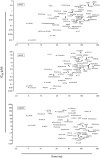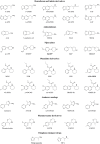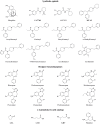Designer drugs: mechanism of action and adverse effects
- PMID: 32249347
- PMCID: PMC7225206
- DOI: 10.1007/s00204-020-02693-7
Designer drugs: mechanism of action and adverse effects
Erratum in
-
Correction to: Designer drugs: mechanism of action and adverse effects.Arch Toxicol. 2022 May;96(5):1489. doi: 10.1007/s00204-022-03244-y. Arch Toxicol. 2022. PMID: 35243532 Free PMC article. No abstract available.
Abstract
Psychoactive substances with chemical structures or pharmacological profiles that are similar to traditional drugs of abuse continue to emerge on the recreational drug market. Internet vendors may at least temporarily sell these so-called designer drugs without adhering to legal statutes or facing legal consequences. Overall, the mechanism of action and adverse effects of designer drugs are similar to traditional drugs of abuse. Stimulants, such as amphetamines and cathinones, primarily interact with monoamine transporters and mostly induce sympathomimetic adverse effects. Agonism at μ-opioid receptors and γ-aminobutyric acid-A (GABAA) or GABAB receptors mediates the pharmacological effects of sedatives, which may induce cardiorespiratory depression. Dissociative designer drugs primarily act as N-methyl-D-aspartate receptor antagonists and pose similar health risks as the medically approved dissociative anesthetic ketamine. The cannabinoid type 1 (CB1) receptor is thought to drive the psychoactive effects of synthetic cannabinoids, which are associated with a less desirable effect profile and more severe adverse effects compared with cannabis. Serotonergic 5-hydroxytryptamine-2A (5-HT2A) receptors mediate alterations of perception and cognition that are induced by serotonergic psychedelics. Because of their novelty, designer drugs may remain undetected by routine drug screening, thus hampering evaluations of adverse effects. Intoxication reports suggest that several designer drugs are used concurrently, posing a high risk for severe adverse effects and even death.
Keywords: Designer drug; New psychoactive substance; Psychedelic; Stimulant; Synthetic cannabinoid; Synthetic opioid.
Conflict of interest statement
The authors declare that they have no conflict of interest.
Figures









References
Publication types
MeSH terms
Substances
LinkOut - more resources
Full Text Sources
Other Literature Sources
Research Materials
Miscellaneous

